This page has been superceded by the new Insulin Pump Choices page. Some of the details here are out of date.
There have been a few changes in the Australian pump landscape recently. One new pump, and one pump getting into trouble with the TGA. And a few other subtler changes. Here’s the latest run-down.
There are currently 6 pumps that can be purchased new through private health insurance:
-
- Accu-Chek Combo
- Accu-Chek Solo
- Tandem t:slim X2 (although sales are currently on hold)
- YpsoPump
- Medtronic 670G, Medtronic 770G
There are also some older pumps still in use, such as:
The consumables for the above pumps are available through NDSS.
As usual I’ll run through them all with brief descriptions. Then I’ll mention other pumps we’re aware of which are not available.
For new pumps to be available in Australia, the first hurdle they need to pass is registration with the Therapeutic Goods Administration (TGA), after which doctors and suppliers are legally allowed to talk about them. The next hurdle is generally getting listing on the Federal Department of Health’s Prostheses List so they’re eligible for supply by health insurance. The Prostheses List was recently updated: effective November 2020.
A note about “closed-loop” systems, those are systems which use your CGM data to dynamically adjust your pump’s delivery of insulin. These are not the mythical complete “artificial pancreas” replacement, but they do add a lot of automation to help you manage your diabetes. For information about the open protocol closed-loop systems, see my separate page on the Australian options.
Pumps available new in Australia
The following pumps are available new. Usually they’re bought through private health insurance, where they’re classified as prosthetic devices. Not all private health policies cover 100% of the cost of these: check with your own insurer as to coverage. But if they cover “pumps” then they’ll cover all of these.
Accu-Chek Combo
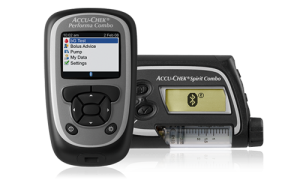 This pump is a relatively old design, but it has proven itself as a reliable performer over the years. The Combo system is comprised of a “Spirit Combo” pump along with a “Performa Combo” BG meter which is used as a remote control so the pump doesn’t have to be brought out of your pocket in normal use.
This pump is a relatively old design, but it has proven itself as a reliable performer over the years. The Combo system is comprised of a “Spirit Combo” pump along with a “Performa Combo” BG meter which is used as a remote control so the pump doesn’t have to be brought out of your pocket in normal use.
The Spirit Combo can hold up to 315U of insulin, and the basal rates can be set to 0.01 U/hr increments in 1-hour blocks. The pump has a luer-lock connection for its infusion sets, so it can be used with any of the Roche/Accu-Chek sets along with the Unomedical (“Animas”) infusion sets, the Cleo 90, the Orbit sets, and Medtronic’s Quick-set.
Currently this is the pump I’ve now been using for a few years, as an in-warranty pump that can be used with the AndroidAPS closed-loop system to integrate with my CGM.
Accu-Chek Solo
 This tubeless patch pump has multiple components, starting with a cannula patch onto which the pump clips. The cannula is 90˚ teflon with two length options. There’s a disposable 200U reservoir which also includes the battery which powers the body of the pump. The pump body nominally lasts 4 months. The Aviva Solo remote controller has an integrated BG meter (although you can enter corrections using a BG value you’ve retrieved from another meter or CGM).
This tubeless patch pump has multiple components, starting with a cannula patch onto which the pump clips. The cannula is 90˚ teflon with two length options. There’s a disposable 200U reservoir which also includes the battery which powers the body of the pump. The pump body nominally lasts 4 months. The Aviva Solo remote controller has an integrated BG meter (although you can enter corrections using a BG value you’ve retrieved from another meter or CGM).
 The Solo pump is not waterproof: you are expected to remove it (leaving the cannula patch in place) for swimming and showers. This is primarily because the battery has to use a “zinc-air” chemistry to get enough capacity, and without access to air the battery stops working.There’s a small vent on the outside of the pump, that if you covered with tape would kill the pump.
The Solo pump is not waterproof: you are expected to remove it (leaving the cannula patch in place) for swimming and showers. This is primarily because the battery has to use a “zinc-air” chemistry to get enough capacity, and without access to air the battery stops working.There’s a small vent on the outside of the pump, that if you covered with tape would kill the pump.
Because the pump body lasts for 4 months, when you buy the pump each year you will receive three bodies. Plus if it’s the first year you’ll receive a handset.
In 2019 I wrote about my experience wearing a dummy Solo (which was non-operational, so was only about the form factor).
Tandem t:slim X2
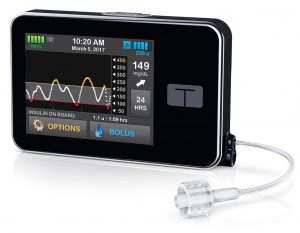 This pump is a small pump with a touchscreen interface. The aluminium case is very robust, and gives it a slight heft in your hand. The internal battery is recharged by USB (typically topped up at least every few days).
This pump is a small pump with a touchscreen interface. The aluminium case is very robust, and gives it a slight heft in your hand. The internal battery is recharged by USB (typically topped up at least every few days).
The insulin reservoir can hold up to 300U. The basal rate can be set with a tiny increment of 0.001 U/hr in 16 arbitrary time blocks. However, the minimum basal rate is 0.100 U/hr (or 0), and this can cause issues for some paediatric use as this minimum also applies to temporary basal rates.
Note that even if your basal rate is 0.6 U/hr, that minimum 0.1 still applies to any temp basal. Thus the lowest TBR you’d be able to apply would be 17%. Not 10%. If your basal rate was 0.3 U/hr you’d only be able to drop to 34%.
The Tandem reservoirs are compatible only with the Tandem t:lock infusion sets. The older reservoirs that could be used with any luer-lock infusion set have been discontinued.
Note that Apidra insulin is not compatible with the Tandem reservoirs (it’s not officially listed for pump use in Australia, but is sometimes used in other pumps). Apidra fails catastrophically in this pump.
Fiasp is officially not supported in the t:slim either, although some people apparently do use it successfully.
The t:slim X2 is rated as IP67 waterproof, which is not quite as robust as the IPX8 rating of most other current pumps. See this article for a discussion of waterproof ratings. Mind you, the IP67 rating does still allow for short-term immersion in water up to a metre deep.
A touted feature of this pump is the ability to update its firmware at home via USB without having to have the whole pump replaced/serviced, and this has already been used to add features to the pump at no direct cost during its 4-year warranty period. Yes, “free” upgrades (although there may be costs involved in getting doctors to sign off on it). The initial version of the pump can act as a Dexcom G5 CGM receiver.
TGA registration suspended!
Currently the t:slim X2 has had its TGA registration suspended (as of November 24, 2020) and this means that new sales of the pump are currently prohibited by law. Support and upgrades for existing pumps is not affected. Note that AMSL is the Australian distributor and support organisation representing Tandem in Australia.
The suspension seems to be related to a problem in the pump’s original firmware which has not been corrected by Tandem. It causes some situations where the battery discharges sooner than expected, and people have had medical emergencies because of situations like the battery going flat in the night and refusing to recharge. We were told this was going to be fixed by a software update, but that has not yet appeared, and eventually the TGA took action.
Hopefully the fix comes through soon. I do suspect the US company Tandem may have moved slowly on this because the software version with the problem is the one that supports the Dexcom G5 CGM (which is no longer supported in the US). We’ll see what happens: hopefully a positive resolution happens soon.
Other t:slim software versions
After the Dexcom G6 became available in Australia (in June 2020) AMSL was able to introduce the “Basal-IQ” firmware update. This enables support for the G6 (but removes support for the G5).
Basal-IQ has a low-glucose-suspend function that suspends and resumes basal insulin as required to keep your BG above 4.4 mmol/l. It was released to US users in August 2018, and has received a lot of positive feedback. It’s a lot finer-grained than the cruder suspend function used in Medtronic’s 640G pump.
Note that the NDSS CGM Subsidy scheme does not yet cover the G6 CGM, so people relying on the government CGM subsidy (such as many children) are not able to upgrade their pumps to Basal-IQ as they would lose access to their G5 CGM.
In November 2020 the TGA did approve Tandem’s subsequent “Control-IQ” firmware update, which is their closed-loop pump control system (it was released in the US at the end of 2019). Control-IQ implements a fairly complete closed-loop system internally within the pump (again, dependent on the use of the Dexcom G6 CGM). It’s been very popular in the US.
Hopefully AMSL will be in a position to supply this update early in 2021 (and hopefully G6 will be added to NDSS at the same time) but time will tell on the specifics.
The t:slim pump is not compatible with any open protocol closed-loop system.
YpsoPump
 The YpsoPump (from Ypsomed) is a tiny unit which links to the MyLife app on your phone via Bluetooth. Currently the app has a one-way connection: it needs the user to use the pump’s touchscreen to issue boluses, but does most of the the rest of the management and connection from the phone (including carb/bolus calculations).
The YpsoPump (from Ypsomed) is a tiny unit which links to the MyLife app on your phone via Bluetooth. Currently the app has a one-way connection: it needs the user to use the pump’s touchscreen to issue boluses, but does most of the the rest of the management and connection from the phone (including carb/bolus calculations).
It seems a series of updates are in the pipeline for the YpsoPump. Integration of Dexcom CGM data into the MyLife app. A pump update that supports bolusing directly from the app, and another update that lets the pump be controlled from a closed-loop controller. Ypsomed have an agreement with Dexcom (who own the TypeZero algorithm) and one option should come from that.
But timelines for these things are not yet announced.
The reservoir holds up to 160U of insulin, and the basal rates can be set to 0.01 U/hr increments in 1-hour blocks. The pump uses the Orbit infusion sets (with steel and teflon options) as well as the YpsoPump Inset (which is identical to the Medtronic Mio, the Tandem AutoSoft 90, and the Animas Inset II).
The reservoir is smaller than in some other pumps, although 160U is enough for many people’s requirements. But the reservoirs are quick and easy to swap in, so I think the 160U limit is unlikely to be a problem for many people. Plus the reservoirs are glass (unlike the plastic of other pumps) and as such are approved for longer-term insulin storage. The tested and approved use includes the ability to pre-fill reservoirs and keep them in your fridge for up to 4 weeks.
The YpsoPump cannot currently be used with any open protocol closed-loop systems.
Medtronic 670G
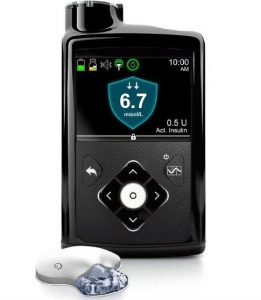 The 670G pump was Medtronic’s first closed-loop system. The pump acts as the receiver for the Guardian3 Link CGM, which it needs for the closed-loop functionality.
The 670G pump was Medtronic’s first closed-loop system. The pump acts as the receiver for the Guardian3 Link CGM, which it needs for the closed-loop functionality.
The pump is supplied with a linked “Contour Next Link 2.4” BG meter. The meter, pump, and CGM sensors communicate via a radio protocol which is not Bluetooth.
The reservoir in the 670G can hold up to 300U of insulin (it can also use a 180U reservoir), and the basal rates can be set to 0.025 U/hr increments in 30-minute blocks.
The Guardian3 CGM has sensors that last for 7 days, and require calibration within every 12 hours.
With its CGM the 670G is able to have the same SmartGuard function as the 640G, as well as having “auto mode” which is their closed-loop system. Note that it is a first-generation looping system and lacks many of the configuration options and features of the open protocol loop systems (such as the inability to customise the target BG level) although it is approved by the regulators and available without you having to assemble it yourself. The 670G is not compatible with any external closed-loop systems.
Like all loop systems it needs “care and feeding”: hopefully people don’t assume it’s going to be a “magic pill” which will fix everything for them automatically.
Medtronic 770G
 The Medtronic 770G is a development from the 670G. The looping algorithm is the same, with the same fixed 6.7 mmol/L target. But it will be software-upgradeable to the enhanced algorithms of the 780G pump which is still being used in clinical trials.
The Medtronic 770G is a development from the 670G. The looping algorithm is the same, with the same fixed 6.7 mmol/L target. But it will be software-upgradeable to the enhanced algorithms of the 780G pump which is still being used in clinical trials.
Note that while the 770G promises to be upgradeable, there are conflicting reports from Medtronic as to whether the upgrades will be free or not (unlike with the Tandem pump).
The 770G does have a few extra features over the 670G, such as:
It has Bluetooth integrated into the pump. This is used to link the pump to your mobile phone (with the CareLink app uploading to the cloud). No longer do we have to choose to either have the CGM connected to the phone or to the pump. We finally get both!
The CGM uses the same Guardian sensors, but a new transmitter which uses Bluetooth (like the older Guardian Connect transmitters, but not apparently not identical).
The pumps are shipped with Accu-Chek Guide Link BG meters (instead of the Contour Next Link 2.4) which are intended to connect to the pump via Bluetooth. However it seems this function won’t be available until at least 2021.
Other pumps in use in Australia
While not available new, the following pumps are still in use by many people.
Medtronic 640G
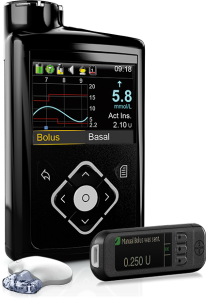 This pump originally integrated with Medtronic’s Guardian2 Link CGM, but also supports the Guardian3 Link that was introduced with the 670G.
This pump originally integrated with Medtronic’s Guardian2 Link CGM, but also supports the Guardian3 Link that was introduced with the 670G.
It uses that data for “SmartGuard” which is their predictive-low-glucose-suspend (sometimes referred to as a “hypo minimiser”) although this function is dependent on keeping the CGM calibrated and accurate.
The pump is supplied with the same BG meter as the 670G, and the reservoir capacity and consumables are the same.
The 640G is not compatible with any closed-loop system.
Medtronic Paradigm “Veo” (554 or 754 models)
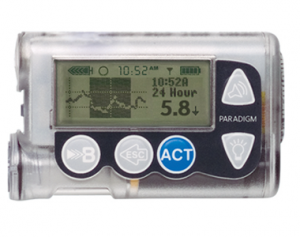 These were Medtronic’s earlier generation of pumps. The consumables (reservoirs and infusion sets) are still used with the current 770G.
These were Medtronic’s earlier generation of pumps. The consumables (reservoirs and infusion sets) are still used with the current 770G.
The reservoir in the 554 can hold up to 180U of insulin, and the 754 can hold up to 300U (or use the 180U option). The basal rates can be set to 0.025 U/hr increments in 30-minute blocks.
The pumps support Medtronic’s old “Enlite” CGM system (uses the same sensors as the Guardian2 CGM, but a different transmitter) and they have a primitive low-glucose-suspend function (which suspends when you get to the boundary point, not when the pump predicts you’re soon going to get there).
These pumps were originally rated with IP67 dust/waterproofing, but especially given their age I would not regard any of them as waterproof today.
The latest firmware versions of these pumps are not compatible with any open protocol closed-loop systems. Older versions with firmware up to 2.7A are “loopable” and supported by all three opensource closed-loop systems (OpenAPS, Loop, and AndroidAPS). As are many other older Paradigm models.
Animas Vibe
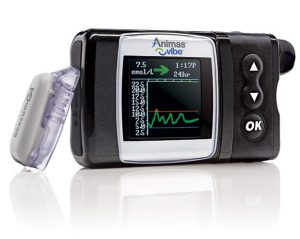 Animas shut down and discontinued this pump (back in early 2018). The transition took a while, and supply of reservoirs lasted until February 2020.
Animas shut down and discontinued this pump (back in early 2018). The transition took a while, and supply of reservoirs lasted until February 2020.
The Vibe reservoir can hold up to 200U, and the basal rates can be set to 0.025 U/hr increments in 30-minute blocks. The pump has an integrated receiver for the Dexcom G4 CGM system. The Vibe is NOT compatible with any closed-loop systems.
DANA R and RS
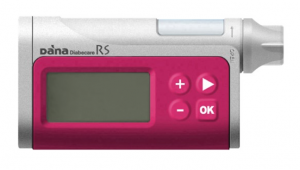 The DANA R and RS pumps look almost identical. The main differences are the R’s use of Bluetooth 2 rather than the lower-power Bluetooth LE, and a correspondingly-worse battery life (approximately a third of the lifespan).
The DANA R and RS pumps look almost identical. The main differences are the R’s use of Bluetooth 2 rather than the lower-power Bluetooth LE, and a correspondingly-worse battery life (approximately a third of the lifespan).
The pumps have a 300U insulin reservoir, and basal rates can be set to 0.01 U/hr increments in 1-hour blocks.
They use DANA-specific infusion sets (including a teflon one made by Ypsomed and equivalent to the OrbitSoft set). The OrbitMicro steel cannulae (available on NDSS without tubing) can be used with the DANA tubing if you need to use those. For a long time there has been talk of “Inset” infusion sets for the DANA, and these are now reaching the market in some parts of the world. We’re yet to see if they reach Australia.
The special batteries for the pump are supplied in each box of reservoirs. The supplier (Managing Diabetes) has ceased sales of the RS (largely due to their exhorbitant costs for importing the special Lithium batteries in today’s economy) but is still supporting current users. The upcoming DANA-i (see below) looks like it will be their replacement product.
Both the R and RS pumps are supported by the AndroidAPS closed-loop system.
A non-T1D pump
V-Go
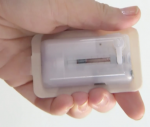 The V-Go is available in Australia, but is designed for use in Type 2 diabetes, not Type 1. It is a simply mechanical (spring-driven) device for 1-per-day use, with a fixed infusion rate. I have previously written about the V-Go.
The V-Go is available in Australia, but is designed for use in Type 2 diabetes, not Type 1. It is a simply mechanical (spring-driven) device for 1-per-day use, with a fixed infusion rate. I have previously written about the V-Go.
Other insulin pumps
That’s it for the current Australian pump options, but there are some other pumps around the world which Australian folk keep asking about.
Medtronic 780G
This is Medtronic’s touted next closed-loop pump. It (or parts of it) are being trialled at some locations around the world. It apparently has Bluetooth for connecting to your phone, but the thing most people talk about is a more-advanced closed-loop algorithm than the 670G. The 770G pump described above seems to be effectively an early release of the hardware for it.
DANA-i
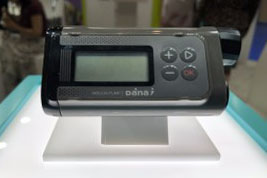 This will be the next pump from SOOIL. It has TGA approval for supply in Australia, but did not reach the November 2020 update to the Prostheses List that controls which pumps private health insurance will fund.
This will be the next pump from SOOIL. It has TGA approval for supply in Australia, but did not reach the November 2020 update to the Prostheses List that controls which pumps private health insurance will fund.
It uses the same reservoirs and infusion sets as the DANA RS, but uses a standard AAA battery. It is a bit bigger and “chunkier” than the RS pump though.
The DANA-i has apparently begun delivery to customers in NZ already, but it’s a waiting game for all the pieces to fall into place for Australia.
The pump does have a few technical advances over the RS other than just a new battery, such as: a new Bluetooth 5.0 module with increased range, and little things like the fact that timestamps are recorded in UTC (with the pump being told what timezone you’re in). This makes travelling across timezones and with DST simpler, with software such as AndroidAPS (in a possible future version) able to manage the transitions smoothly.
But note that the official position from AndroidAPS is still that there are no plans to support the DANA-i at this point. SOOIL is focussing with this pump on supporting commercial loop providers rather than the opensource systems. In Europe this pump is likely to be supported by the commercial CamAPS FX looping system that currently uses the DANA RS and by Diabeloop.
Insulet OmniPod
 This tubeless patch pump is available in the US and Europe, but although medically it’s been approved for use in Australia since 2012 it has never been sold here. The economic model simply doesn’t fit the funding model used in Australia.
This tubeless patch pump is available in the US and Europe, but although medically it’s been approved for use in Australia since 2012 it has never been sold here. The economic model simply doesn’t fit the funding model used in Australia.
Every 3 days a whole new pump is required: the only permanent piece is the “PDM” remote controller. This would shift most of the cost from your health insurance to the NDSS which supplies consumables, and no-one’s been able to work out a compromise. It also produces a lot of hard-to-recycle waste. But the pump can be worn during swimming/showering/etc. If the pump detaches, it can’t be re-attached.
Incidentally, the old version’s internal name is “Eros”, and uses 433 MHz radio to link the PDM and the pumps. Their new “DASH” system instead uses Bluetooth but it otherwise the same. The Eros OmniPods can be used with opensource closed-loop systems (primarily Loop at the moment). The DASH will be used by Tidepool’s future commercial closed-loop version of Loop, as well as Insulet’s own Horizon closed-loop.
For now I do not expect to see the OmniPod appear in Australia, unless they can somehow shoehorn it into the Australian funding model (or change the way pumps are funded here!).
Accu-Chek Insight
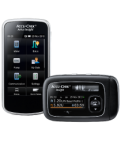 This pump is used in Europe, but not available here (although it was registered with the TGA back in 2015, as well as added to the Prostheses List). It uses essentially the same cartridges as the YpsoPump, but the pre-filled NovoRapid/Fiasp “PumpCart”s used for it in Europe are not yet available in Australia. The end of the pump is actually part of the infusion set tubing (the pump needs its own collection of infusion sets). The Insight is supported by the AndroidAPS closed-loop software.
This pump is used in Europe, but not available here (although it was registered with the TGA back in 2015, as well as added to the Prostheses List). It uses essentially the same cartridges as the YpsoPump, but the pre-filled NovoRapid/Fiasp “PumpCart”s used for it in Europe are not yet available in Australia. The end of the pump is actually part of the infusion set tubing (the pump needs its own collection of infusion sets). The Insight is supported by the AndroidAPS closed-loop software.
I do not expect to see the Insight appear in Australia.
Medtrum A6
 This tubeless patch pump from China has had TGA registration for some time, but does not seem to be on anyone’s marketing plans. Reports from overseas users characterise it as a relatively primitive device (especially its controller device).
This tubeless patch pump from China has had TGA registration for some time, but does not seem to be on anyone’s marketing plans. Reports from overseas users characterise it as a relatively primitive device (especially its controller device).
Currently I do not expect to see the Medtrum reach the Australian market.
Kaleido
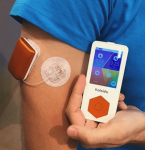 A patch pump from the Netherlands, Kaleido has a similar form factor to the now-defunct Cellnovo system, but also allows you to use longer tubing for flexibility in how you wear it. It’s the pump Diabeloop in France chose for their DBLG1 closed-loop system.
A patch pump from the Netherlands, Kaleido has a similar form factor to the now-defunct Cellnovo system, but also allows you to use longer tubing for flexibility in how you wear it. It’s the pump Diabeloop in France chose for their DBLG1 closed-loop system.
Currently I do not expect to see Kaleido reach Australia.
That’s it for now
I’m sure our pump options will continue to evolve, so expect more updates to come!

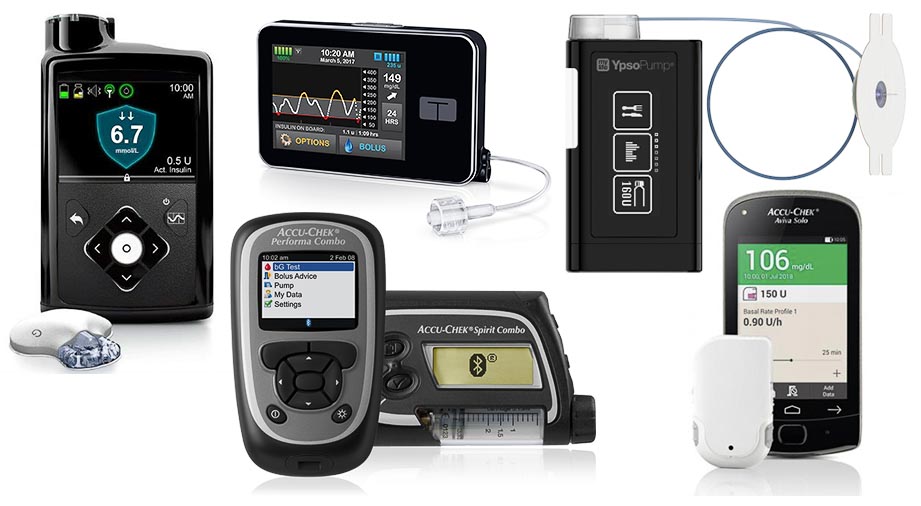
Where is the statement from Medtronic that 770–>780 will not be free? This was not my impression at all. I’m of the understanding that it will be communicated when 780G is approved and available
“In November 2020 the TGA did approve Tandem’s subsequent “Control-IQ” firmware update” = Hello David, this is great news, i am struggling to see this announcement though, is it on the TGA site? Or are you “in the know”? 😉
It was published on the TGA website, but is hard to find now. This may be related to the underlying Tandem pump’s ARTG registration being suspended recently, I’m not sure.
Many thanks, very exciting development though, just hoping the suspension doesn’t put the brakes on it, although as alluded in your article, likely the timing will be just as dependent on NDSS scheduling of G6. A big marketing push to drive adoption of C-IQ around the same time an integral piece of supporting tech becomes more widely available.
By the way, always pleased to see a new post on your site, lets everyone know you are (hopefully) well!
Thanks very much for this article David. I’m due for a pump upgrade soon so found your reviews most helpful.